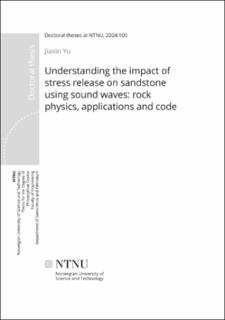| dc.contributor.advisor | Stovas, Alexei | |
| dc.contributor.advisor | Avseth, Per Åge | |
| dc.contributor.author | Yu, Jiaxin | |
| dc.date.accessioned | 2024-04-09T09:42:31Z | |
| dc.date.available | 2024-04-09T09:42:31Z | |
| dc.date.issued | 2024 | |
| dc.identifier.isbn | 978-82-326-7793-1 | |
| dc.identifier.issn | 2703-8084 | |
| dc.identifier.uri | https://hdl.handle.net/11250/3125469 | |
| dc.description.abstract | The acoustic and elastic responses of sandstones vary with changes in effective stress. Laboratory measurements have indicated that among different types of sandstones, velocities and elastic moduli of weakly cemented sandstone show asymmetrically much more sensitivity to effective stress increases than effective stress decreases. Numerous sandstone rock physics models available in the literature are proposed based on the assumption of perfect linear elasticity, which limits the applicability of most models to explain the behavior of weakly cemented sandstone upon effective stress release. Effective stress imposed on a rock is typically defined as the difference between the overburden stress and the pore pressure when the stress coefficient is assumed to be unity. Effective stress release scenarios in practice often involve an increase in pore pressure within reservoir rock due to injection, as well as a reduction in overburden stress caused by uplift and erosion of the rock. However, there is a scarcity of quantitative studies in the literature examining the impact of stress release on various aspects, such as estimating uplift in overconsolidated rock and utilizing 4D seismic monitoring for fluid injection. Compared to high porosity weakly cemented sandstone, unconsolidated sands are more extensively studied. Laboratory experiments and well-log data have demonstrated that the acoustic and petrophysical properties of mechanically compacted overconsolidated sands differ from those of normally consolidated sands. However, there is currently no documented research exploring the similarities and differences between these two types of sandstone in an overconsolidated state. This understanding is crucial both from an academic standpoint and in practical applications. This dissertation addresses the above questions in a sequential manner. Moreover, in order to promote ongoing research on stress release and encourage innovation in rock physics, the models and knowledge gained during the completion of this dissertation have been incorporated into an open-source Python library. This library serves as a valuable resource for the scientific community, providing access to the developed models and facilitating further exploration and advancements in the field of rock physics. | en_US |
| dc.language.iso | eng | en_US |
| dc.publisher | NTNU | en_US |
| dc.relation.ispartofseries | Doctoral theses at NTNU;2024:100 | |
| dc.relation.haspart | Paper 1: Yu, Jiaxin; Duffaut, Kenneth; Avseth, Per Åge. Stress sensitivity of elastic moduli in high-porosity cemented sandstone — Heuristic models and experimental data. Geophysics 2023 ;Volum 88.(4) s. MR185-MR194. © 2023 Society of Exploration Geophysicists. Available at: https://doi.org/10.1190/geo2022-0425.1 Presented as Chapter 2 in the thesis. | en_US |
| dc.relation.haspart | Paper 2: Yu, Jiaxin; Duffaut, Kenneth; Avseth, Per Åge. Understanding the synergistic impact of stress release and cementation on sandstone using sound waves - Implications for exhumation estimation. Geophysics 2023 ;Volum 88.(6) s. MR333-MR349. Copyright © 2023 Society of Exploration Geophysicists. Available at: https://doi.org/10.1190/geo2023-0015.1 Presented as Chapter 3 in the thesis. | en_US |
| dc.relation.haspart | Paper 3: Effects of overconsolidation and stress release on seismic rock physics: A comparative study between unconsolidated sands and weakly cemented sandstone. Presented as Chapter 4 in the thesis. This paper is submitted for publication and is therefore not included. | en_US |
| dc.relation.haspart | Paper 4: Yu, Jiaxin; Mukerji, Tapan; Avseth, Per Åge. rockphypy: An extensive Python library for rock physics modeling. SoftwareX 2023 ;Volum 24. s. – Published by Elsevier. This is an open access article under the CC BY-NC-ND license. Available at: http://dx.doi.org/10.1016/j.softx.2023.101567 Presented as chapter 5 in the thesis. | en_US |
| dc.title | Understanding the impact of stress release on sandstone using sound waves: rock physics, applications and code | en_US |
| dc.type | Doctoral thesis | en_US |
| dc.subject.nsi | VDP::Teknologi: 500::Berg‑ og petroleumsfag: 510 | en_US |

